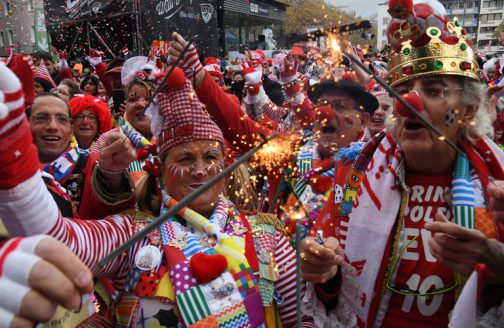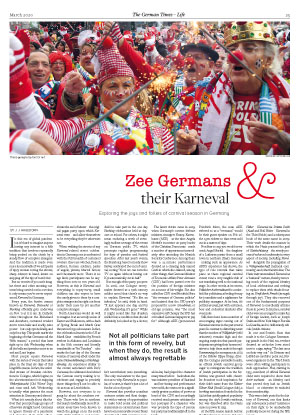Zee Germans and their Karneval
 This is going to be fun! Or not.
This is going to be fun! Or not.Credit: imago images / Chai von der Laage
In this era of global pandemics, it’s hard to imagine anyone having any interest in a folk tradition that involves repeatedly being pecked on the cheek by a steady flow of complete strangers. And the tradition is made even more inconceivable if we add packs of tipsy women roving the streets, sharp scissors in hand, intent on snipping off the tips of men’s ties.
But no worries if you can’t imagine these and other amusing customs being carried out in our time, it only means you’ve never experienced Karneval in Germany.
Every year, the festive season known as Karneval, Fastnacht or Fasching officially gets underway on Nov. 11 at 11:11 am. In Catholic cities throughout the Rhineland and elsewhere, costumed revelers storm town halls and loudly seize power – but only symbolically, and only for a day. This prank marks the beginning of what Germans call the “fifth season,” a period that lasts right up to Ash Wednesday, when all the balls and parades come to an end and Lent begins.
Most people equate Karneval with the series of events that takes place in the final six days of this long fifth season. In fact, the unbridled stream of drunken celebrations in Cologne, which begins on the abovementioned tie-snipping Weiberfastnacht (Old Wives’ Day) and runs until Ash Wednesday, is usually what garners the most attention in Germany and abroad.
What is it exactly about this festival that prompts large groups of otherwise straight-laced Germans to ignore threats of a pandemic and abandon their stark adherence to stereotypically rigid rules of social conduct? While we’ve all seen images of Germans in Lederhosen consuming pitchers of beer and sausage at the annual Oktoberfest in Munich, what in this case compels them to dress up as Pippi Longstocking and dive with élan into the candies and kisses of Karneval?
The answer is simple: it’s the very notion of role reversal that makes Karneval such a hoot. The modern form of this centuries-old tradition was established in 1823 and encouraged Germans to turn the world on its head and forget about all the things they worry about during the rest of the year. For one crazy week, they take over the streets of their city, gather together, make music, drink to their heart’s content, celebrate the end of winter – the original pagan party upon which Karneval rests – and allow themselves to be everything they’re otherwise not.
When walking the streets of any Karneval-related street celebration in Germany, one is confronted with the full breadth of costumed revelers: there are witches, French soldiers, Roman soldiers, packs of angels, pirates, Marvel heroes and thousands more. There is no age limit; participants can be anything from zero to 100 years old. However, as this is Karneval and everything is topsy-turvy, small children can also expect to have the candy given to them by a complete stranger stolen right out from under their nose by yet another complete stranger.
North Americans would do well to imagine it as an unruly union of Easter and Halloween, with a dash of Spring Break and Mardi Gras thrown in for good measure. In fact, the celebration known in the US as Mardi Gras – established by French settlers in Alabama and Louisiana in the 18th century and literally translatable as “fat Tuesday” – also marks the last day of the German version of carnival, albeit under the name Fastnachtdienstag or Faschings-
dienstag. An experience similar to the events associated with Rio’s Carnaval, the ultimate idea behind the German merry-making is to celebrate and engage in precisely those things they’ll not be able to do as soon as Lent kicks in.
However, not everyone is so gung-ho about the southern revelry. Those who live in northern Germany’s traditionally more Protestant areas have been known to watch the goings-on in the south with slight irritation and puzzlement. And there are always some Karneval-resistant residents of southern German towns who vow to stay indoors or even take flight during the days leading up to Ash Wednesday. In 2015, the satirical website Der Postillon announced that northern Germany would be officially accepting Karneval as legitimate grounds for granting asylum to individuals seeking refuge from the Jecken, or jesters, in the Karneval-ravaged south.
Indeed, Karneval means different things to different people. For people in Cologne and Mainz, it brings a week of street parties, where even their local bank teller might be swigging a beer while dressed as a clown. For someone up in Berlin or Kiel, it might mean making a colorful costume for their child to take part in the one-day Fasching celebrations held at daycare or school. For others, it might mean enduring a week of seemingly endless coverage of the events on German public TV, which preempts regular programming for days of parades and festival speeches. After last year’s events, the Hamburg-based comedy show Extra3 celebrated the end of carnival, noting “Now we can turn the TV on again without having our IQs automatically cut in half.”
But enough of the party-poopers.
In 2018, one Cologne merry-maker dressed as a 19th-century soldier noted that there’s no way to explain Karneval: “It’s like an infection,” he said, drink in hand. “It just appears one day, and by Ash Wednesday, it’s gone.” While it might sound like this drunken soldier has a condition that should definitely be looked at by a doctor, he’s nevertheless onto something. The only real answer to the question as to why Karneval is so popular, of course, is that it’s just a lot of fun for a lot of people.
Karneval also provides countless costume artists and float designers with a variety of opportunities to make bold social and political statements on current issues: there have been memorable recent floats depicting the VW emissions scandal, Brexit, right-wing dictatorships and an endless array of large-scale, mobile commentaries on political figures of all stripes.
Which brings us to Politischer Aschermittwoch (political Ash Wednesday), an umbrella term for the evenings of political potshots and satire organized during carnival season by Germany’s major political parties at the local and regional level. The practice was made popular at the start of the last century in Bavaria by groups of farmers wishing to have their voice heard, but these days, Der Spiegel describes the events as more like “a party conference in a slightly drunk parallel universe.” Not all politicians take part in this form of revelry, but when they do, the result is almost always regrettable.
The latest victim came in 2019, when Germany’s current defense minister, Annegret Kramp-Karrenbauer (AKK) – at the time Angela Merkel’s successor as party leader of the Christian Democrats – made a number of appearances immediately after attending the Munich Security Conference. Among them was a 25-minute performance dressed as a cleaning lady named Gretl in which she claimed, among other things, that German Minister of Economic Affairs Peter Altmaier (CDU) had been passed over for the position of foreign minister on account of his weight. She also called her CDU-rival Friedrich Merz “the revenant of German politics” and insisted that the SPD party’s proposal for a new Grundrente, or old-age pension, was “the most expensive self-therapy the SPD has ever asked German taxpayers to pay for.” Although AKK (pronounced ah-ka-ka) had played the character many times before – back when she was minister president of Saarland – and her timing and performance were solid, she was now in a significantly greater position of power as head of the CDU and accordingly received much greater criticism for her portrayal of a character who was precisely the type of person her party has traditionally left in the lurch.
It was yet another speech, however, in which she referred to the “Latte Macchiato faction” in Berlin and appeared to make fun of bathrooms for third-gender people, that actually sparked a major debate and led to a drop in her approval ratings. And it was only months later, just two weeks before the 2020 Politischer Aschermittwoch, that AKK announced she was giving up the position of CDU head and would not run as a candidate for chancellor in 2021. Perhaps the thought of having to give up her Gretl character at the next Karneval celebrations was too much to bear.
Meanwhile, the 2020 Politischer
Aschermittwoch gathering organized by the local CDU in the Thuringian town of Apolda enjoyed tremendous buzz after announcing that Friedrich Merz, the man AKK referred to as a “revenant,” would be their guest speaker on Feb. 26: the 1,300 tickets to that event sold out in a matter of days.
Needless to say, you would never catch Angel Merkel – the daughter of a Lutheran pastor from a small town in northern (East) Germany – making such an appearance. As AKK’s experience has shown, the type of role reversal that takes place at these regional carnival events runs a very tangible risk of not translating well to the national stage. In other words, at its worse, Politischer Aschermittwoch is a minefield for politicians, a feeding-frenzy for journalists and a nightmare for publicity managers. At its best, it’s politics as usual, just with costumes, beer and orchestral rimshots after every joke.
Still, there have been a number of encouraging signs coming out of Karneval universe in the past several years. In contrast to disturbing news that the number of Wildpinkler (wild urinaters) remains high and the ongoing suspicion that parade participants are giving their horses sedatives to help them make it through Rosenmontag, the emergence in 2019 of the Kölsche Kippa Koepp, (literally the Cologne yarmulke heads), an official Jewish carnival group eager to reinvigorate the tradition of Jewish participation in the festivities, was greeted with cheers. Its founders took inspiration for their club’s name from the Kleiner Kölner Klub (Small Cologne club), a bowling association founded in the 1920s that quickly gained popularity among the city’s Jewish residents, but was dissolved after the Nazis came to power in 1933.
At the fifth-season launch held at the Tanzbrunnen stage in Cologne last November, the Kölsche Kippa Köpp was invited by the city’s oldest carnival club (Die Grosse von 1823 e.V.) to join them and 10,000 revelers in making it clear – especially in light of the recent anti-Semitic attack in Halle – that xenophobia had no place in Cologne. As this was Karneval, however, where everything is turned on its head, instead of a moment of silence, they showed their joint distaste for racism by clapping loudly and nonstop for one minute.
Yet, as with all traditions in Germany going back more than a hundred years, it’s worth investigating any potential skeletons in the Karneval closet. This is exactly what historians Carl Dietmar and Marcus Leifeld did in a 2008 TV documentary called Alaaf und Heil Hitler – Karneval im Dritten Reich (Alaaf and Heil Hitler – Karneval in the Third Reich) and a subsequent book of the same name in 2009. Their work details the manner in which the Nazis pursued the goal of Gleichschlatung – the steady process of enforced conformity in every aspect of society, including Karneval – alongside the propagation of a Volksgemeinschaft (national community) and other fascist ideas. The Nazis instrumentalized Karneval as a “national” custom, thereby removing much of the regional identity of local celebrations and seeking to replace them with rituals focusing on Kraft durch Freude (strength through joy). They also removed one of the fundamental purposes of Karneval: to mercilessly criticize those in power. In its place, carnival clubs were encouraged to make fun of foreign leaders, such as Joseph Stalin and New York Mayor Fiorella La Guardia, and to deliberately ridicule Jewish citizens.
In one anti-Semitic float that made it to the Cologne Rosenmontag parade in the Nazi era, revelers dressed as orthodox Jews stood next to a sign saying “The last ones on their way out.” As Dietmar and Leifeld are careful to point out, Karneval organizers in the Third Reich were often willing participants in such approaches. Plus, starting in 1935, members of official Karneval clubs were required to show their Arier-nachweis – an identity card that proved they had no Jewish blood – or otherwise be excluded from membership.
This was a dark period in the history of Karneval, one that limits any subsequent jesters’ insistence on their right to be unabashedly politically incorrect during the fifth season.
And it’s true, for all of its revelry, Karneval will always be a serious business. Love it or hate it, it remains a multimillion-dollar industry that attracts hundreds of thousands of tourists every year. Indeed, when the key ingredient to your festival is alcohol, you can be sure that each new generation will provide a steady flow of jokers and jesters. There will also always be naysayers, who make the most of the opportunity to gripe and look down on the revelers.
Either way, as the 19th-century soldier explained, the infection will go on appearing and disappearing before you know it.
J. J. Hagedorn
is an author living in Berlin.




